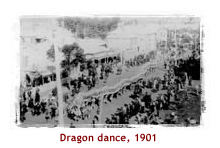 |
Identity 1900

At the time of Federation most Western Australians saw themselves as
British subjects first, as Western Australians second, and as Australians
third. The creation of the new Commonwealth was not seen as an impediment
to being an integral part of the British Empire - if anything the formation
of a single Commonwealth Defence Force and other Australian institutions
would strengthen and contribute to the defence of Empire.
Few Western Australians saw Federation as a radical break from Britain
and the significance of creating a new nation was downplayed by many.
As the Western Australian Federal League limply argued "federation
makes us practically a self-governing nation".
Australian nationalism operated within the constraints of Imperial identity. As colonists, Australians were strangers in a strange land, holding on to a British identity in the face of the continent's indigenous people and their Asian neighbours. Little wonder that among the first actions of a fledgling nation were the exclusion and denial of its native inhabitants and the introduction of a White Australia Policy.
As in the other Australian colonies endemic racism, coupled with enthusiasm for the monarchy, were at the core of a Western Australian identity, which was further shaped by the colonists' sense of isolation.
 For t'othersiders living in the goldfields their emotional connection with the eastern colonies, and with Victoria in particular, found expression in the belief in an Australian identity. Among the sandgropers, a Western Australian identity was linked directly with ideas of Empire. For t'othersiders living in the goldfields their emotional connection with the eastern colonies, and with Victoria in particular, found expression in the belief in an Australian identity. Among the sandgropers, a Western Australian identity was linked directly with ideas of Empire.
It is interesting that the enthusiastic celebrations surrounding the visit
of the Duke and Duchess of Cornwall and York in 1901, who were oficially
visiting Australia to open the inaugural Federal Parliament in Melbourne,
make no reference to the Commonwealth. The Royal Visit was an Imperial
and a Western Australian one.
|
 |